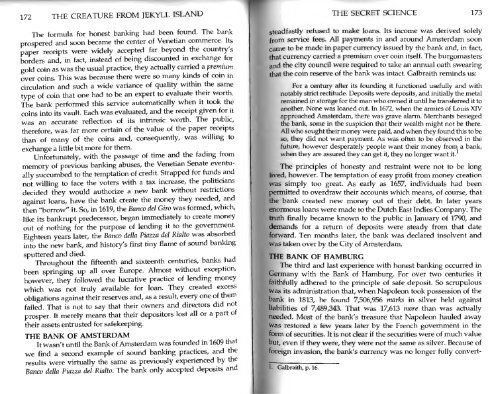Create successful ePaper yourself
Turn your PDF publications into a flip-book with our unique Google optimized e-Paper software.
172 THE CREATURE FROM JEKYLL ISLAND<br />
The formula for honest banking had been found. The bank<br />
prospered and soon became the center of Venetian commerce. Its<br />
paper receipts were widely accepted far beyond the country's<br />
borders and, in fact,<br />
instead of being discounted in exchange for<br />
gold coin as was the usual practice, they actually carried a premium<br />
over coins. This was because there were so many kinds of coin in<br />
circulation and such a wide variance of quality within the same<br />
type of coin that one had to be an expert to evaluate their worth.<br />
The bank performed this service automatically when it took the<br />
coins into its vault. Each was evaluated, and the receipt given for it<br />
was an accurate reflection of its intrinsic worth. The public,<br />
therefore, was far more certain of the value of the paper receipts<br />
than of many of the coins and, consequently, was willing to<br />
exchange a little bit more for them.<br />
Unfortunately, with the passage of time and the fading from<br />
memory of previous banking abuses, the Venetian Senate eventually<br />
succumbed to the temptation of credit. Strapped for funds and<br />
not willing to face the voters with a tax increase, the politicians<br />
decided they would authorize a new bank without restrictions<br />
against loans, have the bank create the money they needed, and<br />
then "borrow" it. So, in 1619, the Banco del Giro was formed, which,<br />
like its bankrupt predecessor, began immediately to create money<br />
out of nothing for the purpose of lending it to the government.<br />
Eighteen years later, the Banco della Piazza del Rialto was absorbed<br />
into the new bank, and history's first tiny flame of sound banking<br />
sputtered and died.<br />
Throughout the fifteenth<br />
and sixteenth centuries, banks had<br />
been springing up all over Europe. Almost without exception,<br />
however, they followed the lucrative practice of lending money<br />
which was not truly available for loan. They created excess<br />
obligations against their reserves and, as a result, every one of them<br />
failed. That is<br />
not to say that their owners and directors did not<br />
prosper. It merely means that their depositors lost all or a part of<br />
their assets entrusted for safekeeping.<br />
THE BANK OF AMSTERDAM<br />
It wasn't until the Bank of Amsterdam was founded in 1609 that<br />
we find a second example of sound banking practices, and the<br />
results were virtually the same as previously experienced by the<br />
Banco della Piazza del Rialto, The bank only accepted deposits and<br />
THE SECRET SCIENCE 173<br />
steadfastly refused to make loans. Its income was derived solely<br />
All payments in and around Amsterdam soon<br />
from service fees.<br />
came to be made in paper currency issued by the bank and, in fact,<br />
that currency carried a premium over coin itself. The burgomasters<br />
and the city council were required to take an annual oath swearing<br />
that the coin reserve of the bank was intact. Galbraith reminds us:<br />
For a century after its founding it functioned usefully and with<br />
notably strict rectitude. Deposits were deposits, and initially the metal<br />
remained in storage for the man who owned it until he transferred it to<br />
another. None was loaned out. In 1672, when the armies of Louis XIV<br />
approached Amsterdam, there was grave alarm. Merchants besieged<br />
the bank, some in the suspicion that their wealth might not be there.<br />
All who sought their money were paid, and when they found this to be<br />
so, they did not want payment. As was often to be observed in the<br />
future, however desperately people want their money from a bank,<br />
when they are assured they can get it, they no longer want it.<br />
The principles of honesty and restraint were not to be long<br />
lived, however. The temptation of easy profit from money creation<br />
was simply too great. As early as 1657, individuals had been<br />
permitted to overdraw their accounts which means, of course, that<br />
the bank created new money out of their debt. In later years<br />
enormous loans were made to the Dutch East Indies Company. The<br />
truth finally became known to the public in January of 1790, and<br />
demands for a return of deposits were steady from that date<br />
forward. Ten months later, the bank was declared insolvent and<br />
was taken over by the City of Amsterdam.<br />
THE BANK OF HAMBURG<br />
The third and last experience with honest banking occurred in<br />
Germany with the Bank of Hamburg. For over two centuries it<br />
faithfully adhered to the principle of safe deposit. So scrupulous<br />
was its administration that, when Napoleon took possession of the<br />
bank in 1813, he found 7,506,956 marks in silver held against<br />
liabilities of 7,489,343. That was 17,613 more than was actually<br />
needed. Most of the bank's treasure that Napoleon hauled away<br />
was restored a few years later by the French government in the<br />
form of securities. It is not clear if the securities were of much value<br />
but, even if they were, they were not the same as silver. Because of<br />
foreign invasion, the bank's currency was no longer fully convert-<br />
1- Galbraith, p. 16.


